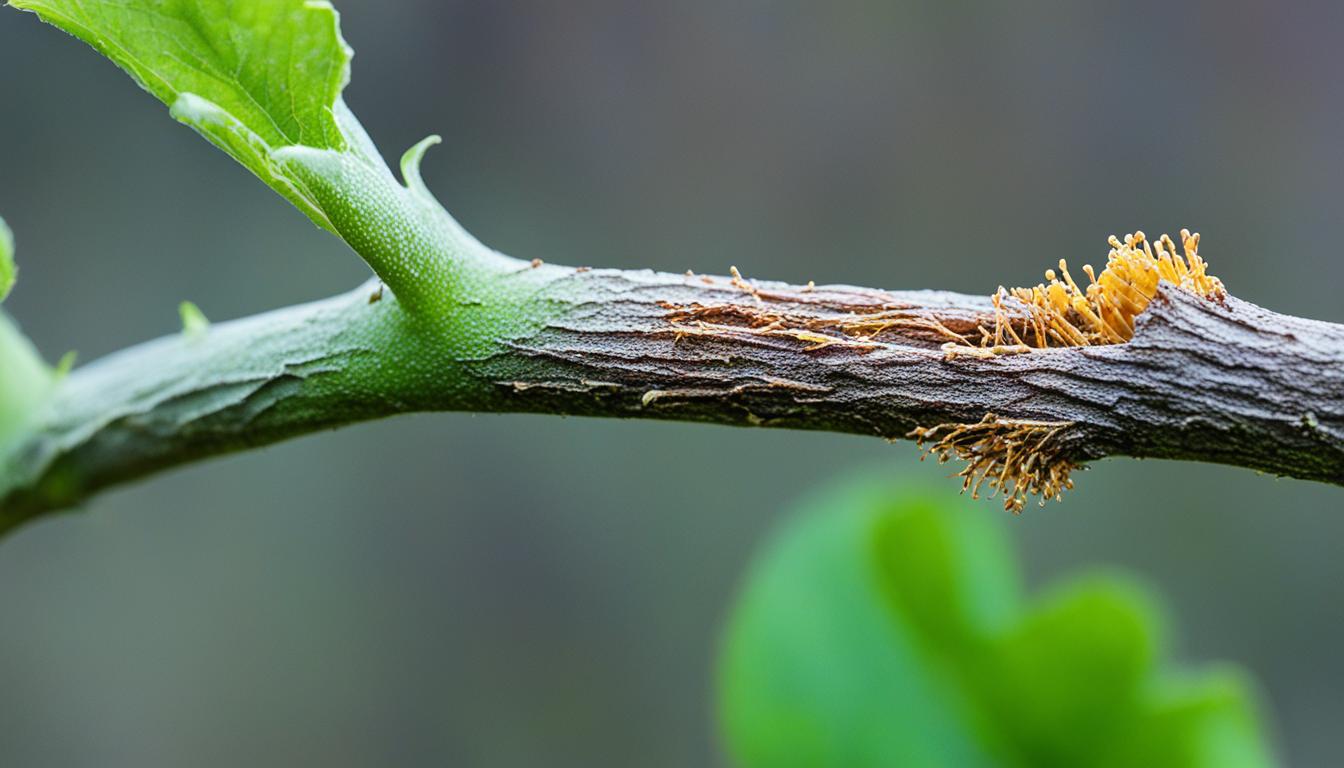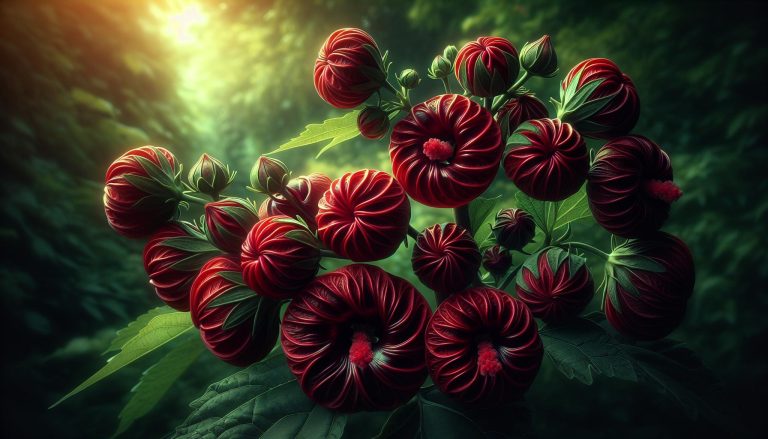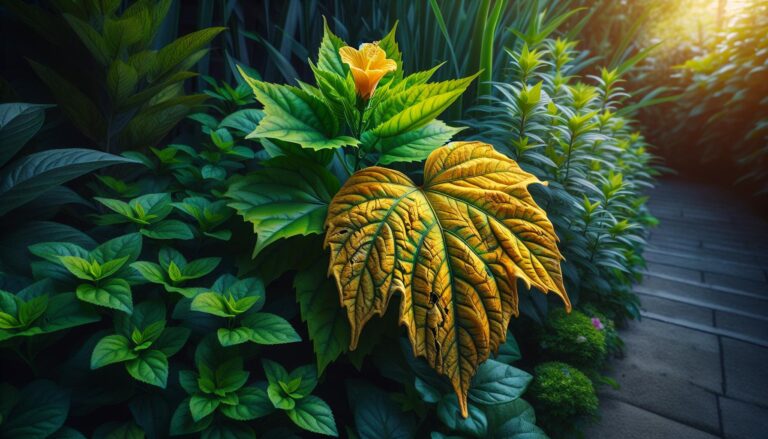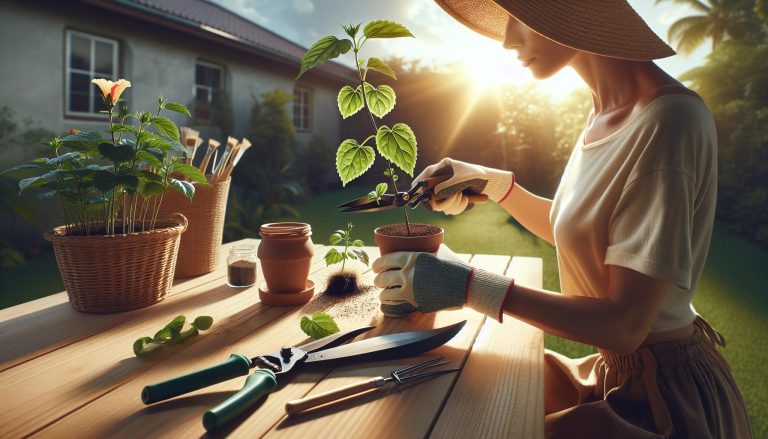Identifying a Dormant Hibiscus Plant – Key Traits
Imagine walking through a beautiful garden filled with vibrant blossoms and lush foliage. Among the array of flowers, you spot a hibiscus plant with its stunning, showy blooms. However, as winter approaches, the once vibrant hibiscus plant starts to exhibit signs of dormancy.
Picture this: The leaves of the hibiscus plant gradually fade from their lush green color to a pale yellow, and one by one, they start to drop, leaving bare stems standing tall. The plant’s growth slows down considerably, and its branches appear woody, as if frozen in time.
This is the appearance of a dormant hibiscus plant, a natural phase that hibiscus plants go through during the winter months. While it may seem disheartening to witness the vibrant blooms disappear, understanding these key traits of dormancy is essential for proper care and maintenance of your hibiscus plants.
Key Takeaways:
- A dormant hibiscus plant exhibits traits such as leaf drop, slow growth, and woody branches.
- Understanding these traits is crucial for providing the necessary care during the winter months.
- Proper pruning and protection from frost are essential for a dormant hibiscus plant’s health.
- Caring for a hibiscus plant in dormancy involves providing less water and creating a suitable environment.
- By recognizing the signs of dormancy, you can ensure your hibiscus plants thrive and bloom again when the time is right.
The Lifecycle of a Hardy Hibiscus Plant
Hardy hibiscus plants, also known as perennial hibiscus, go through a lifecycle that includes a dormant phase in winter. These plants are herbaceous perennials, meaning their stems die back to the ground during winter. The plant may appear woody during this time, with no visible leaves. It is important to provide proper care and protection to ensure their survival during the winter months.
Understanding the Dormant Phase
During winter, hardy hibiscus plants enter a period of dormancy. The above-ground parts of the plant die back, and its energy is focused on root development and storage. This is a natural response to colder temperatures and reduced daylight.
When this phase begins, the hardy hibiscus plant’s stems will become bare and appear woody. The vibrant leaves that adorned the plant during the warmer months may have shed, leaving behind dormant stems.
Proper Winter Care for Hardy Hibiscus Plants
To ensure the survival of hardy hibiscus plants during winter, it is crucial to provide them with appropriate care and protection.
- Pruning: Before the first frost, prune the plant back to around six inches above the ground. This helps reduce the risk of disease and promotes healthy regrowth in the spring. Remove any dead or damaged stems.
- Insulation: Around the base of the plant, apply a layer of mulch or compost to provide insulation and protect the roots from freezing temperatures.
- Watering: While hardy hibiscus plants are dormant, they require less water. Water sparingly, ensuring the soil remains slightly moist but not overly wet.
- Protection from Frost: If the winter temperatures in your area drop to extreme lows, consider protecting the plant further by covering it with a frost cloth or moving it indoors to a cool location.
Spring Awakening
As winter comes to an end and temperatures rise, the hardy hibiscus plant will emerge from its dormant phase. New growth will appear from the dormant stems, and leaves will return, bringing the plant back to life.
With proper care and protection during winter, your hardy hibiscus plant will thrive and reward you with its stunning blooms once again.
How to Care for a Dormant Hibiscus Plant
Caring for a dormant hibiscus plant is crucial to its survival during the winter months. Understanding the specific needs of the plant and providing the right conditions will ensure its health and prepare it for a vibrant return when spring arrives.>
Watering Considerations
During dormancy, hibiscus plants require less water compared to their active growth period. It’s important to water them sparingly to prevent overwatering, which can lead to root rot. Allow the soil to dry out slightly between waterings, ensuring that the plant receives enough moisture to sustain it without becoming waterlogged.
Leaf Drop: A Natural Process
One common trait of a dormant hibiscus plant is leaf drop. As the plant enters its rest phase, it naturally sheds some or all of its leaves. This process is normal and should not cause alarm. The hibiscus will redirect its energy towards root development and conserving nutrients until the next growing season.
Pruning for Health
Proper pruning plays a crucial role in caring for dormant hibiscus plants. Prune away any dead or diseased branches to promote overall plant health. Trimming back the plant also helps to control its size and shape. It is advisable to prune just before the plant enters or emerges from dormancy for the best results.
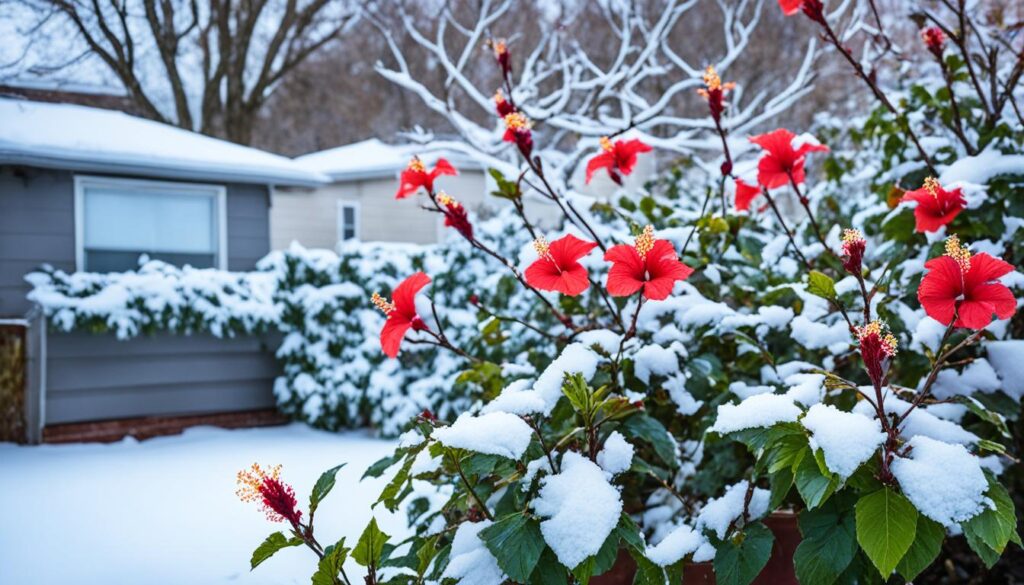
Protection from Frost
Protecting hibiscus plants from frost is essential, especially for those grown in colder climates. Frost can damage the plant’s delicate tissues and hinder its recovery in the spring. To safeguard your hibiscus from freezing temperatures, consider wrapping the plant with frost cloth or bringing it indoors to a protected location.
By providing the necessary care and attention to your dormant hibiscus plant, you can ensure its well-being during the winter. Understanding the unique traits of a dormant hibiscus, adjusting watering practices, pruning when necessary, and protecting it from frost will set the stage for its successful growth and blooming season.
Understanding Different Types of Hibiscus Plants
When it comes to hibiscus plants, there is a wide variety to choose from. Let’s explore three distinct types: hardy hibiscus, tropical hibiscus, and shrub hibiscus. Each type has its own unique characteristics and requirements.
1. Hardy Hibiscus
Hardy hibiscus, also known as cold-hardy hibiscus, is a great option for those who experience harsh winters. These hibiscus plants can tolerate low temperatures and are suitable for regions with colder climates. With their vibrant flowers and impressive size, hardy hibiscus adds a burst of color to any garden. They are often referred to as “dinner plate hibiscus” due to the large size of their blooms.
2. Tropical Hibiscus
If you live in a frost-free climate or want to enjoy hibiscus blooms indoors, tropical hibiscus is the perfect choice for you. These plants thrive in hot and humid environments, making them a popular option for tropical regions. Tropical hibiscus plants produce large, showy flowers in a variety of colors. They are often cultivated as houseplants in colder regions, bringing a touch of the tropics indoors.
3. Shrub Hibiscus
Shrub hibiscus, also known as rose of Sharon or althea, is a versatile and beautiful addition to any landscape. These hibiscus plants have woody stems and are known for their abundant flowers in shades of pink, purple, blue, and white. Shrub hibiscus can reach heights of up to 12 feet and attract butterflies and hummingbirds to your garden. Their resistance to deer makes them a popular choice for those dealing with wildlife in their area.
By understanding the different types of hibiscus plants, you can choose the variety that best suits your climate and personal preferences. Whether you opt for the cold-hardy beauty of hardy hibiscus, the tropical allure of tropical hibiscus, or the versatile charm of shrub hibiscus, these plants are sure to bring joy and beauty to your garden.
Characteristics of a Tropical Hibiscus Plant
Tropical hibiscus plants, scientifically known as Hibiscus rosa-sinensis, are a popular choice for gardening enthusiasts in frost-free climates or as vibrant houseplants. These stunning plants are known for their large, showy flowers that come in a wide variety of colors, including vibrant reds, pinks, yellows, oranges, and whites. The petals of the tropical hibiscus often have an exquisite ruffled appearance, adding an extra touch of elegance to their blooms.
Tropical hibiscus plants thrive in hot, humid climates and require full sun to reach their full potential. They are best suited for USDA hardiness zones 9-11. These plants prefer well-draining soil and benefit from regular watering, keeping the soil evenly moist but not waterlogged.
When it comes to temperature, tropical hibiscus plants are sensitive to cold weather. They should be protected from temperatures below 50°F, as prolonged exposure to chilly conditions can cause damage to the plant. It’s important to note that when transitioning the tropical hibiscus from outdoors to indoors, it may experience some leaf drop as it adapts to the change in environment. This is a normal response and should not cause alarm.
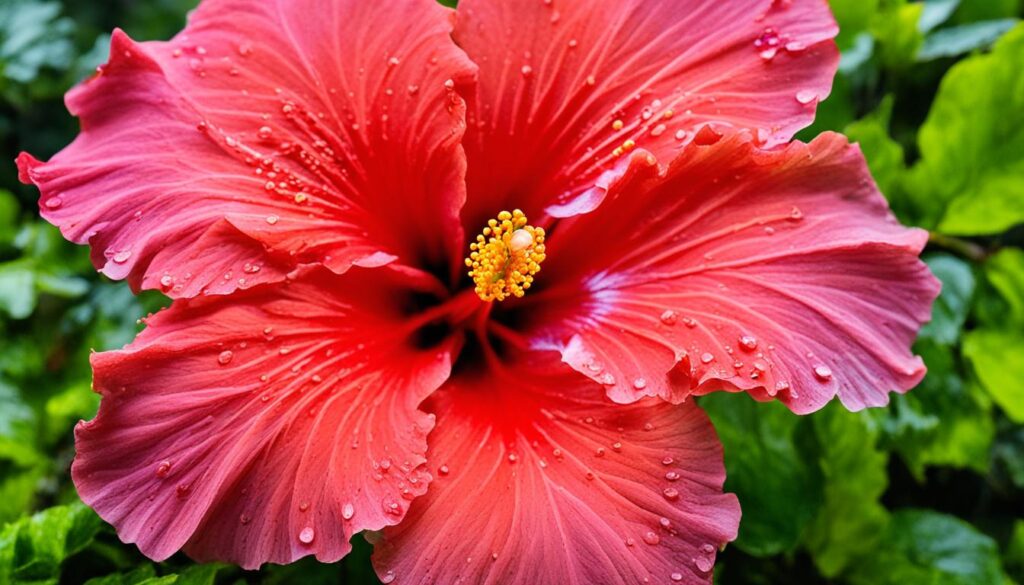
Key Characteristics of Tropical Hibiscus Plants:
- Large, showy flowers in vibrant colors
- Ruffled petals for an extra touch of elegance
- Thrive in hot, humid climates
- Require full sun for optimal growth
- Sensitive to temperatures below 50°F
- May experience leaf drop when transitioning indoors
- Best suited for USDA hardiness zones 9-11
| Tropical Hibiscus Appearance | Traits |
|---|---|
| Flower Size | Large, showy |
| Flower Colors | Vibrant: reds, pinks, yellows, oranges, whites |
| Petal Shape | Ruffled |
| Growth Conditions | Hot, humid climates; full sun |
| Temperature Sensitivity | Below 50°F |
| Leaf Drop | May occur during transition to indoor environments |
| Hardiness Zones | USDA zones 9-11 |
Key Traits of a Hardy Hibiscus Plant
Hardy hibiscus plants, also known as perennial hibiscus, possess unique characteristics that distinguish them from other varieties. These herbaceous perennials undergo a natural process where they die back to the ground during winter, only to re-emerge in the spring. With the ability to survive colder temperatures compared to most hibiscus species, hardy hibiscus plants thrive in zones 4-9. They produce stunning, eye-catching flowers often referred to as “dinner plate hibiscus” due to their large size and vibrant colors.
Hardy hibiscus plants are known for their robust nature, making them ideal for gardeners who desire a resilient and long-lasting addition to their landscape. These plants exhibit a variety of flower colors, including shades of red, pink, and white, which can instantly elevate the aesthetic appeal of any garden or outdoor space. Additionally, their perennial nature ensures that they come back year after year, bringing forth their stunning blooms to delight garden enthusiasts.
Identifying a Shrub Hibiscus Plant
Shrub hibiscus plants, scientifically known as Hibiscus syriacus, are commonly called rose of Sharon or althea. These plants have woody stems and bushy forms, with flowers in shades of pink, purple, blue, and white. Shrub hibiscus is a hardy shrub that thrives in full sun and can reach heights of up to 12 feet.
One distinguishing factor of the shrub hibiscus is its abundant and colorful flowers. The blooms can vary in size and appear in various hues, adding a vibrant touch to any garden or landscape. These flowers attract butterflies and hummingbirds, making the shrub hibiscus a delightful addition to any pollinator-friendly garden.
Unlike the herbaceous perennial hibiscus varieties that die back to the ground in winter, shrub hibiscus maintains its woody structure year-round. This makes it an excellent choice for adding structure and visual interest to your garden, even during the colder months. The bushy form of the shrub hibiscus also provides privacy and can be used as a natural fence or hedge.

With its resistance to deer and ability to withstand various weather conditions, the shrub hibiscus is a low-maintenance plant suitable for both beginner and experienced gardeners. It adapts well to different types of soil, as long as it is well-draining, and can tolerate periods of drought.
Whether you’re looking to add a pop of color, attract wildlife, or create a privacy screen, the shrub hibiscus, also known as rose of Sharon, is a versatile and beautiful addition to any garden or landscape.
Caring for Hibiscus Plants in Winter
Proper care is essential for hibiscus plants during the winter months. As they enter dormancy, hibiscus plants require less water and should be watered sparingly. Protection from frost is crucial, especially for tropical and hardy hibiscus plants. Techniques such as wrapping the plants or bringing them indoors can help prevent damage from freezing temperatures.
Watering Considerations
During the winter, hibiscus plants enter a period of dormancy where their growth significantly slows down. As a result, they require less water compared to the active growing season. It’s important to carefully monitor the soil moisture and avoid overwatering, as excessive moisture can lead to root rot. Water your hibiscus sparingly, ensuring the top few inches of soil are dry before giving it a light drink.
Protecting from Frost
Frost is a major concern for hibiscus plants during the winter, especially for tropical and hardy varieties. Frost can damage the delicate plant tissues and lead to leaf damage or even plant death. To protect your hibiscus from frost, consider the following techniques:
- Wrap the plants: Before the first frost, wrap your hibiscus plants with burlap or frost cloth to provide insulation. This protective covering helps retain heat and shields the plants from freezing temperatures.
- Bring them indoors: If you have potted hibiscus plants, consider bringing them indoors before the onset of frost. Place them near a sunny window or provide supplemental grow lights to ensure they receive sufficient light during their dormant phase.
By taking these protective measures, you can help safeguard your hibiscus plants from the damaging effects of frost and increase their chances of thriving when the warmer temperatures return.
| Winter Care Mistakes to Avoid | Why? |
|---|---|
| Overwatering | Excess water can lead to root rot and other fungal issues in hibiscus plants during dormancy. |
| Insufficient Protection from Frost | Frost can cause irreversible damage to hibiscus plants, including leaf damage and plant death. |
| Placing Plants in Low-Light Areas | Hibiscus plants still require adequate light even during dormancy. Placing them in low-light areas can result in weak growth and reduced vigor. |
Pruning and Propagating Hibiscus Plants
Proper pruning is an important aspect of caring for hibiscus plants. Whether it’s pruning hibiscus for maintenance or to promote healthy growth, knowing the right techniques can help your plants thrive. Additionally, propagating hibiscus plants allows you to expand your collection or share the beauty of these vibrant blooms with others.
Pruning Hardy Hibiscus Plants
When it comes to pruning hibiscus, hardy hibiscus plants should be pruned down to the ground in either fall or spring before new growth emerges. This helps rejuvenate the plant and encourages healthier and more vigorous blooming. By removing the old growth, you create space for new shoots and enhance the overall appearance of the plant.
Pruning Shrub Hibiscus Plants
If you have shrub hibiscus plants, also known as rose of Sharon, it’s recommended to prune them in early spring to maintain their shape and promote better flowering. Trimming back the branches helps to stimulate new growth and ensure a well-maintained and visually appealing plant.
Propagating Hibiscus Plants
Propagating hibiscus plants can be done through two main methods: stem cuttings and seeds. Stem cuttings are the most common and reliable way to create new hibiscus plants. Take stem cuttings in spring or early summer by selecting healthy, non-flowering shoots and trimming them just below a leaf node. Remove the lower leaves and dip the cut end in rooting hormone before planting in a well-draining potting mix.
Seeds can also be used to propagate hibiscus, but it’s important to note that they may not produce flowers identical to the parent plant. Collect mature pods with fully developed seeds and remove the seeds for planting. Sow them in a seed-starting mix and provide the necessary warmth and moisture for germination.
| Method | Best Time | Advantages |
|---|---|---|
| Stem Cuttings | Spring or early summer | – Produces identical plants – Faster results – Easy to control growing conditions |
| Seeds | Spring | – Potentially new varieties – Lower cost – Fun and rewarding experience |
Both pruning hibiscus and propagating them are important practices to keep your plants healthy and flourishing. Whether you’re rejuvenating your existing plants or creating new ones, these techniques allow you to enjoy the beauty of hibiscus plants all year round.
Overwintering Tips for Hibiscus Plants
Overwintering hibiscus plants requires special attention to ensure their survival. As the winter months approach, it’s crucial to take proactive measures in protecting your hibiscus against freezing temperatures and providing optimal care. Here are some tips to help you successfully overwinter your hibiscus plants:
1. Protecting against Freezing Temperatures
When temperatures drop below freezing, hibiscus plants are vulnerable to cold damage. To protect your hibiscus from extreme cold:
- Wrap the plants with burlap or frost blankets. This provides an extra layer of insulation and shields the plants from frost.
- If you have potted hibiscus plants, consider moving them indoors to a well-lit area, such as a sunny window or a greenhouse.
2. Providing Adequate Sunlight and Humidity
Hibiscus plants thrive in sunlight and require at least six hours of direct sunlight per day. If you choose to bring your hibiscus indoors, place them near a window where they can receive ample sunlight. Additionally, ensure the plants are in a humid environment.
3. Consistent Watering and Nutrient Feeding
Although hibiscus plants are dormant during winter, they still require regular watering. Water the plants sparingly, allowing the soil to dry slightly between waterings. Avoid overwatering, as excessive moisture can lead to root rot. Feeding your hibiscus with a balanced fertilizer once a month will provide the necessary nutrients to support its health during the dormant period.
By following these overwintering tips, you can protect your hibiscus plants from winter hardships and ensure their successful emergence when spring arrives.
Common Pests and Diseases of Hibiscus Plants
Hibiscus plants, like any other plant, can fall victim to various pests and diseases. It’s crucial to be aware of these common issues to protect the health and vitality of your hibiscus. By understanding the pests and diseases that can affect your hibiscus, you can take proactive measures to prevent and manage them.
Hibiscus Pests
Several pests can pose a threat to your hibiscus plants. Here are some common ones to watch out for:
- Aphids: These small, soft-bodied insects suck sap from the hibiscus plant, leading to stunted growth and distorted leaves.
- Japanese Beetles: These metallic green beetles feed on the leaves, flowers, and buds of hibiscus plants, causing severe damage.
- Mealybugs: These tiny insects with a cotton-like, waxy coating can infest hibiscus plants, causing stunted growth and honeydew secretion.
- Spider Mites: These microscopic arachnids feed on the sap of hibiscus plants, leading to yellowing leaves, webbing, and overall decline.
Hibiscus Diseases
In addition to pests, hibiscus plants can also be susceptible to various diseases. Here are some common hibiscus diseases to be aware of:
- Leaf Spot: This fungal disease causes circular or irregular brown spots on the leaves of hibiscus plants.
- Blight: Blight is a fungal disease that can lead to wilting, browning, and death of hibiscus plant tissues.
- Rust: Rust is a fungal infection that typically appears as orange or reddish-brown spots on the undersides of hibiscus leaves.
To minimize the risk of pest and disease infestations, it’s important to maintain proper hibiscus plant care. Adequate spacing between plants, regular watering, and good airflow can help prevent these issues. If you notice signs of pests or diseases on your hibiscus plants, take immediate action to control and treat them before they cause irreparable damage.
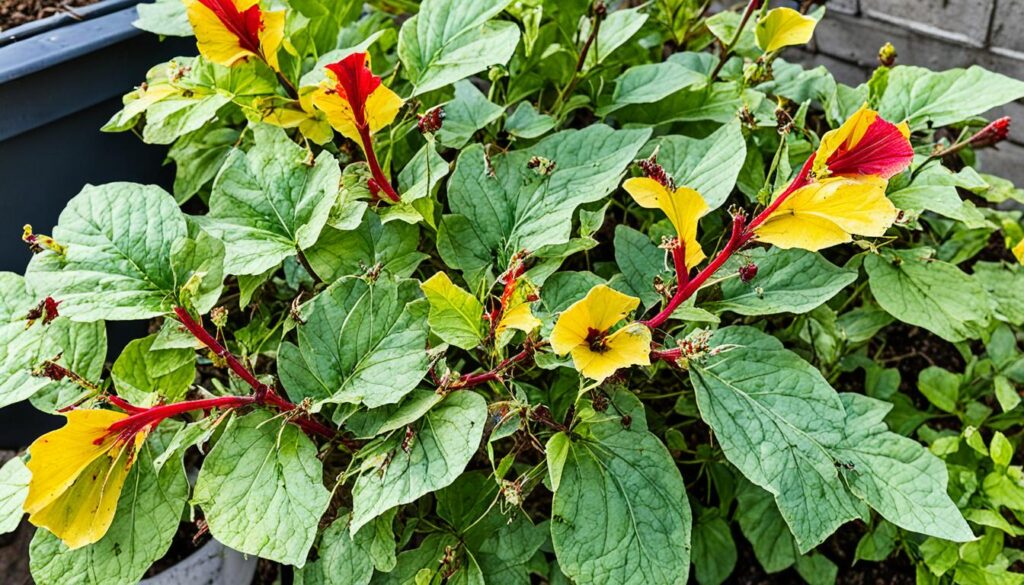
Common Pests and Diseases of Hibiscus Plants
| Pests | Diseases |
|---|---|
| Aphids | Leaf Spot |
| Japanese Beetles | Blight |
| Mealybugs | Rust |
| Spider Mites |
Conclusion
In conclusion, understanding the characteristics and requirements of dormant hibiscus plants is crucial for their care and maintenance. Whether you have a tropical, hardy, or shrub hibiscus, each type has specific needs during the winter months to ensure its health and survival. By implementing proper pruning techniques, protecting the plants from frost, and providing the necessary conditions, you can enjoy vibrant hibiscus blooms when the plants emerge from dormancy.
Remember that hibiscus care is not limited to the active growing season. Taking care of your hibiscus during its dormant phase is just as important. By following the guidelines outlined in this article, you can provide the best care for your hibiscus plants year-round.
Whether you are a beginner or an experienced gardener, incorporating these hibiscus care practices will help you maintain healthy plants and achieve stunning results. So, embrace the beauty of hibiscus flowers by providing the care they need, even when they are dormant.

